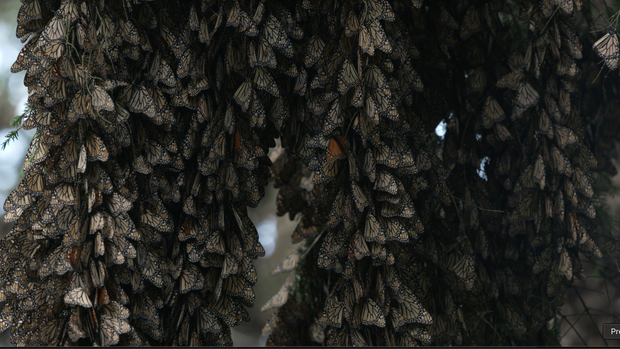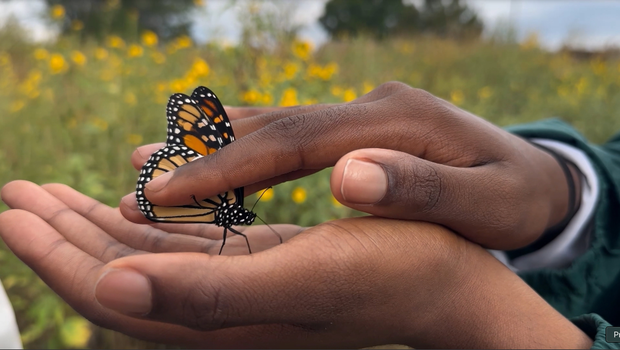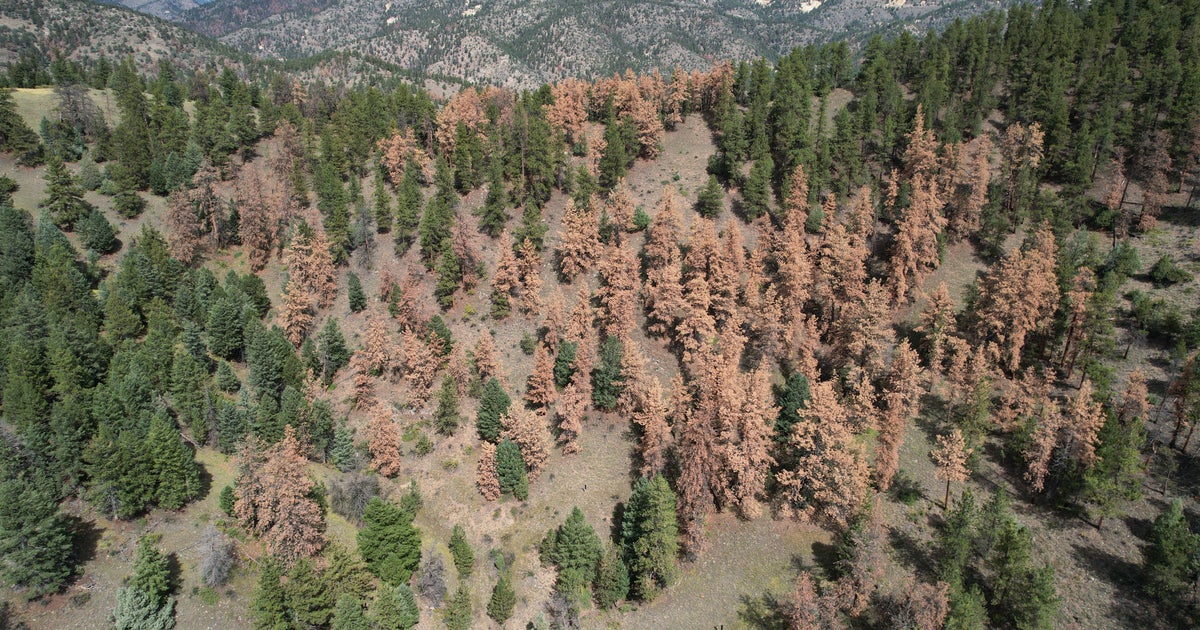Monarch butterfly super generation live up to 9 times longer than most monarchs, migrates thousands of miles
This is an updated version of a story first published on April 20, 2025. The original video can be viewed here.
Earlier this year we reported on one of the most remarkable and mysterious migrations in the natural world happening every spring from Mexico to the United States. Tens of millions of monarch butterflies are on an epic aerial journey home. They've spent the winter hanging out in trees in a forest on a remote mountain in Mexico, resting up after flying all the way from Canada and the northern U.S. where they were born. It's believed monarchs have been making this journey for thousands of years, but there's a lot fewer of them than there used to be. The population in Mexico has declined 70% in the last 30 years. We arrived there in February, just in time to watch the monarchs emerge from their slumber, and begin to take flight.
The monarchs come to these mountains in Michoacan in central Mexico starting in late October.
Anderson Cooper: Do you still get excited going up to see them?
Jorge Rickards: Every time. There's no substitute.
One of our guides Jorge Rickards is the director of the nonprofit World Wildlife Fund in Mexico.
Jorge Rickards: We are going to leave the horses walk a little bit, very, very carefully and very quietly so we won't disturb the butterflies.
The monarchs roost in patches of fir and pine trees 11,000 feet up. There are some 66 million of them here, but it's hard to see them at first. There are what appear to be clumps of dead leaves hanging from sagging branches. But those are butterflies, tens of thousands of them clustered together in trees all around.
Anderson Cooper: There're so many of them on the branches of the trees, the-- the-- the branches are all pointing toward the ground.
Jorge Rickards: Imagine, imagine the lightness of a butterfly. And there are so many of them here that they actually bend the trees. And they like the firs because they have so many little leaves or spicules. So there's lots of surface to cling onto.
The monarchs are in a kind of hibernation. On the way here, they've fattened up on nectar, which helps them survive and rest through the long winter months. The climate on this mountain is ideal. The canopy of trees protects the butterflies from storms, and though the air is cool, it's relatively humid so they stay hydrated.
Anderson Cooper: The clusters are so drab when you are looking at them because they have their wings closed.
Jorge Rickards: In many butterflies on the underside is drab or less lightly colored. And that happens in nature a lot. So it is not very inviting…
Anderson Cooper: To a predator…
Jorge Rickards: to a predator.
Anderson Cooper: Why are we whispering?
Jorge Rickards: They're sensitive to sound. They're also sensitive to CO2. So the less we talk, the better. They relate that with a predator as-- other mammal–
Anderson Cooper: So they can sense-like-- like a mouse breathing.
Jorge Rickards: Or-- or a bird.
Anderson Cooper: A bird breathing.
Jorge Rickards: That is right.
On the forest floor all around us, monarchs litter the ground. But most are not dead. They've just fallen from trees during the night, and their muscles are too cold for them to fly.
Cup them in your hands, you can revive them with your breath.
Jorge Rickards: They need a certain temperature to get their wing muscles back.
Jorge Rickards: They are very, very vulnerable when they're on the floor. And the birds know that. And the mice know that. That's almost ready. There you go.
Anderson Cooper: C'mon, little buddy.
Jorge Rickards: Maybe a little more…There you go. Yeah. He likes you.
Anderson Cooper: Wow.
When the sun begins to hit the trees, flashes of orange appear. The monarchs are warming and slowly opening their wings.
Court Whelan: As the day warms up we are going to see more activities.
Court Whelan has been bringing tour groups here and photographing monarchs for more than 20 years.
He shows us a spot where some butterflies have taken flight. Then, after a few minutes, suddenly… the air is filled with them.
Anderson Cooper: This is extraordinary.
Court Whelan: This is it. This is what it's all about. This is-- nature knows when to put on a show, huh, and how to put on a show.
Anderson Cooper: Why have they all now just suddenly taken off?
Court Whelan: So it's a warm day. We're getting a lotta sunlight, so just ramping up, ramping up.
Anderson Cooper: I mean, what's insane is it's not just over here. It's over there. It's over there. I mean–
Court Whelan: It's extraordinary. But yeah, it's all the heat. It's all the sun.
Anderson Cooper: You can actually hear the sound of butterfly wings.
Court Whelan: Yeah.
Anderson Cooper: Let's just be quiet for a second.
Court Whelan: Look at that. Look at-- look at that-- oh my gosh. Whoa.
Court Whelan: This is about as good as it possibly gets.
Court Whelan: It's, like, a snow globe of monarchs.
Anderson Cooper: You got a butterfly on you.
Court Whelan: Oh, there we go.
It's still something of a mystery how these monarchs manage to get here. Most only live about a month. They spend their short lives eating and mating, and females lay eggs.
But in late summer and early fall, what's called a super generation of monarchs appear. Hatched as caterpillars, they transform into chrysalises and then, after a week or two, emerge as butterflies — and that's when they do something extraordinary.
With winter coming, they sense the shorter days and changing temperatures and suppress a key reproductive hormone, a process called diapause, which helps them conserve their energy and live up to nine months, nine times longer than most monarchs.
Anderson Cooper: It's crazy that there's this super generation of monarchs that can make it all the way–
Jorge Rickards: It's amazing.
Anderson Cooper: --and then the rest die off after a month.
Jorge Rickards: What is amazing is how they detonate this process of not developing sexual organs but using that energy for the flight.
Monarchs born west of the Rockies stay there, and migrate shorter distances. It's this super generation, born in Canada and east of the Rockies in the northern United States, that flies to Mexico. Hundreds of millions of them join up on a journey of some 3,000 miles, which can take them three months or longer. To help them find their way, monarchs have circadian clocks in their antennae and navigate using internal compasses that respond to the position of the sun and the Earth's magnetic field.
Anderson Cooper: Why are they coming here?
Jorge Rickards: Well, that's a big mystery. Maybe it's a prehistoric route. Maybe it was determined by geographical conditions in terms of topography. Maybe it had to do with climate.
Anderson Cooper: You're talking about multiple generations who all have this exact same instinct, and know where to go, and all go to the exact same spot.
Jorge Rickards: That's-- that's-- that's one of the most magical things that could happen in the natural world. How do they know?
The monarchs were discovered by researchers on this mountain range in 1975 and the Mexican government declared the area a federal reserve 11 years later. But for decades, illegal logging threatened the butterfly's roosting spots, which once covered as much as 45 acres, it's now down to four and a half. World Wildlife Fund has spent years trying to combat the destruction, assessing the health of the forest, measuring the size of butterfly colonies, and planting trees. They've also worked with local communities and indigenous groups to protect the land and help them profit from tourism. The good news is the forest is rebounding.
Court Whelan: It's just so unusual to see this.
Court Whelan: It's like almost an optical illusion because everything is beating at this weird frequency -- it's like the whole world is, kind of pulsing.
Anderson Cooper: So what-- what are they doing here?
Court Whelan: Yeah, so this is kind of a classic mud puddling of the monarch butterflies. So–
Anderson Cooper: Mud puddling?
Court Whelan: Yeah, mud puddling. It's a real scientific term. So they're mainly after hydration, but butterflies are known to need some trace elements like salts and whatnot. And it doesn't look like much, but just this little bit of water in this mud puddle is enough for them to get some water. And then what'll happen is they'll return to the roost before evening.
After about four months in Mexico, this super generation of monarchs are near the end of their long life cycle. They are finally ready to mate and migrate north to lay their eggs. They'll die before they can make it back to where they were born, and their offspring might not live long enough to get there either, but future generations will -- and there's an army of people trying to help them.
In Kansas, volunteers come out to catch and tag monarchs, so scientists can track their migration. They're recruited by Chip Taylor, an 87-year-old ecologist who's been fascinated by monarchs since he was a child.
Anderson Cooper: There's over 100,000 species of butterflies and moths, but pretty much the only one people know are monarchs. What is it about monarch butterflies?
Chip Taylor: Well, monarchs have got charisma.
Anderson Cooper: Wait – wait a minute. Monarch butterflies have charisma?
Chip Taylor: Well, yeah, they have charisma because they are accessible. They're large. They're beautiful. They're slow. You can catch them.
Taylor founded a nonprofit called Monarch Watch at the University of Kansas 30 years ago, and so far it's helped tag more than two million of them.
Anderson Cooper: How do you tag a butterfly that's so delicate?
Chip Taylor: This is a rough butterfly and it has to go thousands of miles. So it's– it's a pretty tough butterfly.
Anderson Cooper: It's resilient.
Chip Taylor: It's resilient.
But that resilience is being tested. Monarchs returning to the U.S. need milkweed plants to lay their eggs on, it's the only source of food their newly born caterpillars will eat. But milkweed is now hard to find. It's been virtually eradicated on agricultural land, because of genetically modified corn and soybean crops that allow for mass spraying of herbicides.
Monarch Watch encourages people to plant milkweed in their gardens and on public land, creating what they call Monarch Waystations. Fifty thousand of them have been planted so far.
In Mexico those efforts have gotten noticed.
Eduardo Rendon, head of World Wildlife Fund's Monarch Butterfly Program, showed us a tag he recently found.
Anderson Cooper: So this is one of the tags from Monarch Watch from Chip Taylor?
Eduardo Rendon: Exactly. I find maybe 12 meters from over here. Yeah, I was measuring the colony and then I see the ground and I find these tag. But it's the only way that we can to prove that monarchs from United States and Canada come here to overwinter.
Less than 20% of the monarchs that head out on this miraculous migration actually make it to the mountains of Michoacan. Scientists say worsening storms and rising temperatures kill off many, though this past year the number of monarchs that survived the trip nearly doubled.
It was particularly welcome news in Mexico, where the butterflies' arrival in late October coincides with a deeply spiritual celebration, what's known as the Day of the Dead. That's when many here believe the souls of family and friends who've died return to visit their loved ones, and so that's why the butterflies are returning as well.
Anderson Cooper: Local people believe that the monarchs are the returning spirits of–
Jorge Rickards: That is correct.
Anderson Cooper: --of-- of the-- of the dead.
Jorge Rickards: That is correct. Yes. So who knows? Maybe we are actually-- you are reviving-- you're helping someone's astor-- ancestor fly back. Yes, indeed. So it's very magical.
Produced by Denise Schrier Cetta. Associate producers Katie Brennan, Georgia Rosenberg, Grace Conley. Edited by Craig Crawford.










